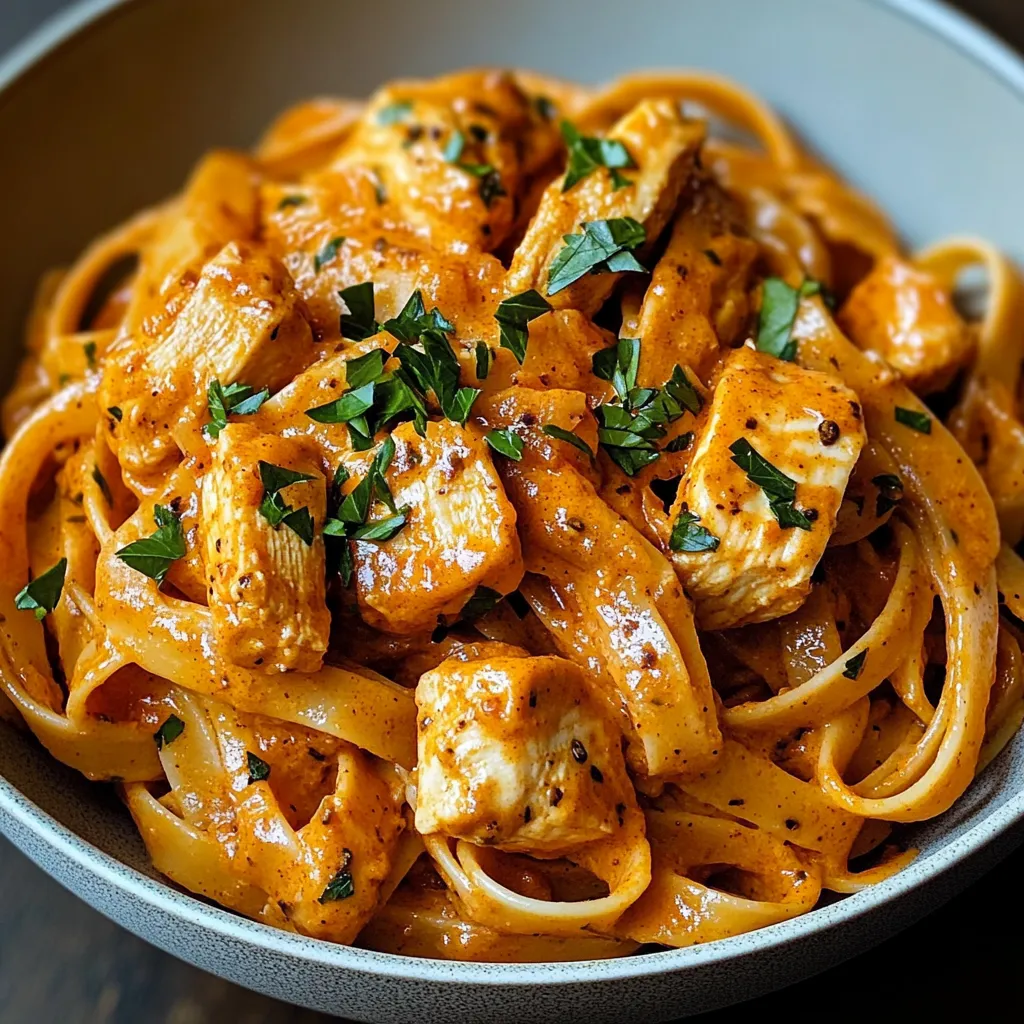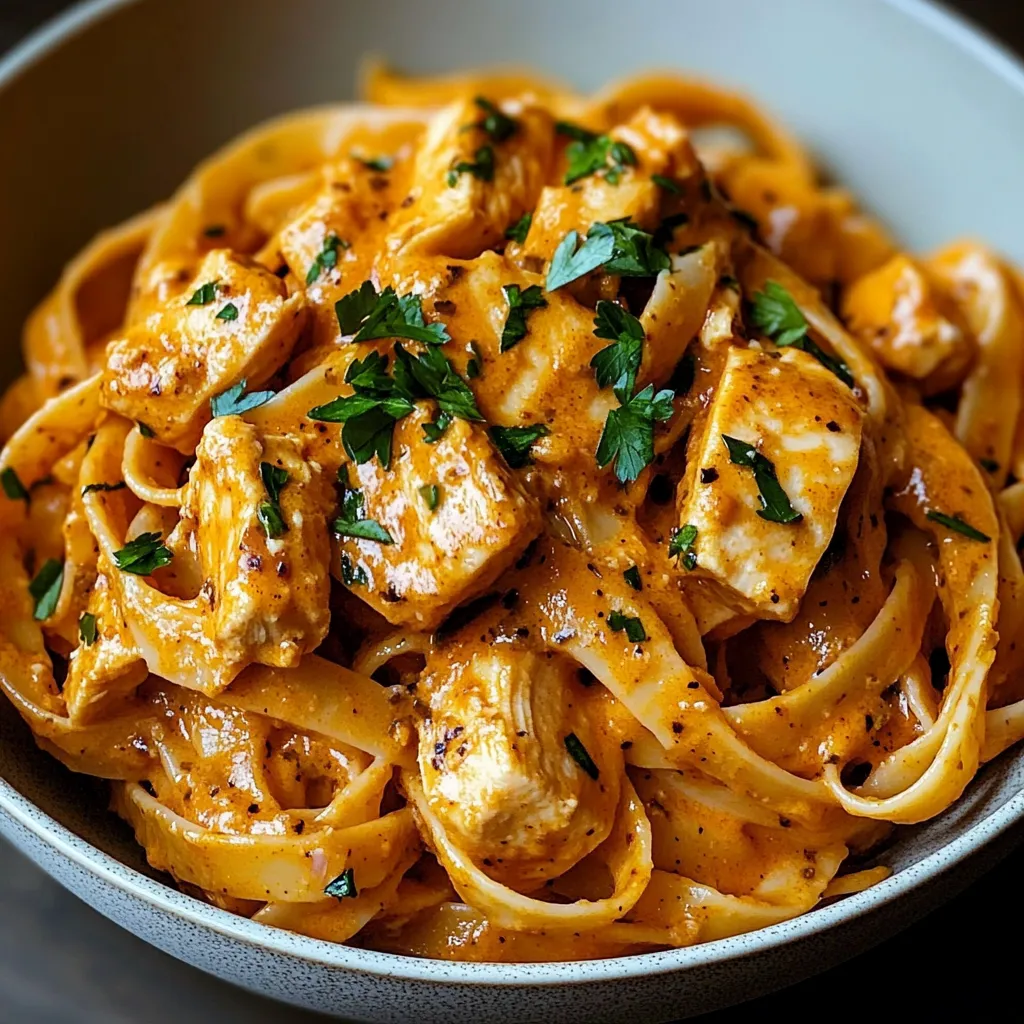 Save
Save
Cowboy butter chicken linguine transforms ordinary pasta into a flavor explosion that satisfies comfort food cravings with minimal effort. The velvety sauce coats each strand of pasta with rich flavor while crispy bacon bits provide bursts of smoky goodness in every bite. This brilliant one-pan wonder transforms simple ingredients into something special that appeals to both children and adults alike, making it the perfect solution for busy evenings.
I discovered this recipe during a particularly hectic week when elaborate cooking seemed impossible. The first time I prepared it, I was astonished by how the aroma of sizzling garlic and butter filled my kitchen with such warmth and comfort. My family gathered around the table without the usual coaxing, and my husband—typically reserved with compliments—proclaimed it 'better than his mother's bacon pasta,' which might be the highest praise possible in our household.
Perfect Ingredients
- Linguine: Creates the perfect vehicle for capturing the rich, creamy sauce. Its ridges and hollows capture sauce in their crevices for perfect flavor in every bite.
- Bacon: Provides the smoky, savory foundation that defines this dish. Choose thick-cut varieties for better texture and flavor.
- Butter: Forms the luxurious foundation of the signature 'cowboy' sauce. High-quality butter delivers noticeably better flavor than margarine or budget varieties.
- Garlic: Infuses essential aromatic notes that enhance all other flavors. Fresh cloves provide significantly more flavor than pre-minced alternatives.
- Heavy Cream: Creates silky smoothness and rich mouthfeel. Its high fat content prevents curdling and ensures a smooth sauce that won't separate during cooking.
- Parmesan Cheese: Adds nutty depth and slight saltiness that complements the rich cream and bacon flavors perfectly.
- Dijon Mustard: Contributes subtle tang and complexity. This seemingly small addition creates remarkable dimension in the finished sauce.
- Red Pepper Flakes: Add the perfect touch of heat without overwhelming. Adjust the amount to match your preferred spice level.
Pasta Perfection
- Pasta Preparation:
- Begin by bringing a large pot of water to a rolling boil before adding a generous amount of salt—it should taste like seawater. This crucial step seasons the pasta from within rather than just on the surface. Cook linguine until al dente, typically 1-2 minutes less than package directions suggest, as it will continue cooking slightly when combined with the sauce.
- Bacon Brilliance:
- While linguine cooks, dice bacon into uniform pieces for even cooking. Place in a cold skillet before turning on heat—this technique renders fat more gradually, resulting in crispier bacon without burning. Cook over medium heat until each piece reaches the perfect crispy-yet-chewy texture, then transfer to paper towels, reserving the flavorful rendered fat in the pan.
- Garlic Infusion:
- Add minced garlic during the final minute of cooking, stirring constantly to prevent burning while releasing its essential oils. This step ensures the garlic flavor permeates the entire dish rather than concentrating in pockets.
- Sauce Development:
- Pour butter into the skillet, using a wooden spoon to scrape any browned bits from the pan bottom. These caramelized particles contain concentrated flavor that enriches the sauce immeasurably. Allow the butter to simmer gently for 5-7 minutes until it begins to bubble slightly.
- Creamy Transformation:
- Add heavy cream to the simmering butter, stirring continuously to prevent curdling. Sprinkle in grated Parmesan cheese, stirring until completely melted and incorporated into the sauce. This careful addition ensures the cheese melts evenly without clumping or becoming grainy.
- Final Flourish:
- Pour in heavy cream while continuing to stir, creating a smooth emulsion. Maintain a gentle simmer rather than boiling, which could cause separation or graininess instead of silky smoothness. Add the drained linguine, tossing gently to coat every piece with the cheesy mixture. The pasta will absorb some sauce and continue cooking slightly in the residual heat.
- Perfect Assembly:
- Add the drained bacon, tossing gently to coat every piece with the sauce. Use a spatula or your fingertips to press it evenly across the bottom. The slight undercooking ensures the pasta won't become mushy when it continues cooking in the sauce.
- Final Baking:
- Cover loosely with foil and bake for 20-25 minutes until the cheese melts completely and begins to bubble at the edges with light golden spots appearing across the top. This moderate baking time allows flavors to meld while creating the perfect cheesy crust without drying out the pasta beneath.
- Rest Period:
- Allow the finished dish to rest for 5-10 minutes before serving. This crucial step lets the layers settle and juices redistribute, making slicing cleaner and preventing the cheese from sliding off when cut.
 Save
Save
My grandmother always emphasized that the magic of cooking lies in understanding how ingredients interact rather than following rigid instructions. When I first attempted this recipe, I rushed the process, resulting in a sauce that was too thin and lacking in richness. Following her wisdom to simmer the sauce slowly and incorporate the cheese gradually transformed my results completely. The difference was remarkable—the sauce became velvety and luxurious, coating each strand of pasta perfectly.
Serving Suggestions
This versatile pasta dish pairs beautifully with various accompaniments that complement its rich, creamy sauce. Serve alongside a crisp Caesar salad with tangy dressing to cut through the richness. Garlic bread or crusty baguette provides the perfect vehicle for sopping up every last bit of the delicious sauce. For a more substantial meal, add a side of roasted vegetables like asparagus or green beans, which provide nutritional balance and color contrast. Consider offering a selection of grated cheeses and fresh herbs for guests to customize their portions.
Creative Variations
Transform this adaptable recipe by experimenting with different ingredients while maintaining the essential 'cowboy butter' flavor profile. Create a seafood version by substituting shrimp or scallops for chicken, reducing cooking time accordingly. Vegetarian adaptations thrive with wild mushrooms providing meaty texture and umami depth. Incorporate fresh thyme, rosemary, or basil for aromatic complexity. For a lighter option, substitute half the heavy cream with milk, though the sauce will be slightly less rich. Different pasta shapes like fettuccine or pappardelle work beautifully for those who prefer varying textures.
Storage Strategy
Maintain optimal flavor and texture by following proper storage techniques. Cool leftovers completely before refrigerating in airtight containers for up to three days. When reheating, add a splash of milk or cream to restore the sauce's silky consistency, warming gently over low heat while stirring occasionally. For individual portions, microwave at 50% power with a damp paper towel covering to maintain moisture. This dish generally doesn't freeze well as the sauce may separate and the pasta texture suffers, so refrigeration is the preferred storage method.
This cowboy butter chicken linguine exemplifies how thoughtful preparation of quality ingredients can create extraordinary results with minimal effort. The balance of creamy richness against bright herbs and gentle heat delivers a sophisticated flavor profile that belies the recipe's simplicity. Whether prepared for a quick weeknight dinner or served to appreciative guests, this pasta delivers the kind of comfort food satisfaction that creates both memories and recipe requests.
 Save
Save
Common Questions About Cooking
- → What is 'cowboy butter' and what makes this dish special?
- Cowboy butter is a flavor-packed compound butter that typically includes garlic, herbs, lemon, and a touch of heat from red pepper flakes. In this pasta dish, these flavors are incorporated into a creamy sauce that coats the linguine and chicken, creating a uniquely rich yet balanced flavor profile.
- → Can I use chicken thighs instead of breasts?
- Absolutely! Boneless, skinless chicken thighs would work wonderfully in this recipe and often stay more tender and juicy. They might need an extra minute or two of cooking time, so ensure they reach 165°F (74°C) internal temperature.
- → How can I make this dish lighter?
- To lighten up this recipe, you can substitute half-and-half for the heavy cream, use less butter, and increase the amount of chicken broth. You could also reduce the amount of Parmesan cheese or use a part-skim version.
- → What sides pair well with this pasta?
- A simple green salad with a light vinaigrette dressing complements this rich pasta nicely. Roasted vegetables like asparagus, broccoli, or Brussels sprouts also make excellent sides, as does garlic bread for those wanting extra indulgence.
- → Can I make this dish ahead of time?
- While best enjoyed fresh, you can prepare components ahead of time. Cook the chicken and make the sauce, storing them separately from the pasta. When ready to serve, reheat the sauce, add a splash of broth or cream if needed, and toss with freshly cooked pasta and the sliced chicken.
